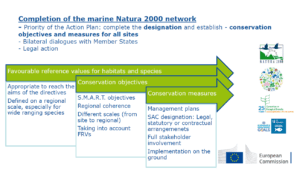Webinar: Management Challenges in Marine N2000 Sites
What is the state of the European Marine environment? Which are the legal instruments to protected marine species and habitats? And what are the challenges for Marine Natura 2000 sites and Marine Protected Areas?
In the last EUROPARC Webinar, we’ve heard from the EU Commission about the current state of our marine environments and heard in first hand the challenges faced by Marine Natura 2000 sites in the Atlantic and Mediterranean regions.
Management Challenges in Marine Natura 2000 Sites
Fotios Papoulias, policy officer from the Nature Protection Unit at DG Environment and responsible for the implementation of the Birds and Habitats in the marine ecosystems, opened the webinar with an overview of the global conservation status of the European marine environment. The scenario is alarming: according to the European Environment Agency (download the EEA State of Nature in Europe Report 2015), about one-third of the marine species and 2 thirds of the marine habitats are in unfavourable conservation status (and for many species and habitats the status is still unknown!).

(extracted from the presentation of Fotios Papoulias, based on the European Environmental Agency – State of Nature in Europe Report 2015
Pollution of marine waters, fishing and (unsustainable) harvesting of aquatic resources are the top two pressures on EU waters, threatening marine ecosystems, according to the European Red List of Habitats, a study commissioned by the DG ENVI in 2016.
Europe’s seas cannot be considered healthy, clean and undisturbed today, and are unlikely to become so in the future given the current trends,
mentioned Mr. Papoulias in his presentation. The protection of the marine environments is, in fact, a key pillar in many international policy frameworks, including the Sustainable Development Goals and the Aichi Targets. In the EU, thanks to the establishment of Marine Natura 2000 sites, around 10% of the EU maritime area is under protection. The expansion of the Natura 2000 network (which has doubled over the past 5 years!) very much contributes to this figure.
However, there are still large EU maritime areas lacking protection, especially in offshore zones. The completion of the marine Natura 2000 network is one of the key objectives of the DG Environment, as it is stated within the EU Action plan for Nature, people and the economy. But the challenge goes beyond the establishment of new protected areas: defining conservation objectives and measures for all sites is imperative.

Ballan Wrasse, Arran Coast – photo by Howard Wood

Download the full presentation of Fotios Papouila
The EU Policy framework for Marine areas
The Habitats & Birds directives are the backbone policy for the establishment of Marine Natura 2000 sites. They foresee tree main overarching objectives:
- implementation of conservation measures
- avoid deterioration
- assessment of plans and projects
To address other challenges such as fisheries, spatial protection measures and maritime spatial plans, other EU legal instruments apply, the Common Fisheries Policy, the Marine Strategy Framework Directive, and the Maritime Spatial Planning Directive, respectively.
Finding funds and inspiration
Despite the legal frameworks, Natura 2000 managers and Marine Protected Areas often lack the financial resources to develop and implement conservation plans. Valentina Cappanera, who presented a case study from the Portofino Marine Protected Area, shared an impressive number of Italian MPAs and Natura 2000 sites that do not have management plans in place, nor funds to do it.
To overcome this barrier, Fotios Papouila advised participants to look for the many financing opportunities under the EMFF, LIFE+ and Interreg. The brochure Life & the Marine Environment highlights some successful projects funded through LIFE+ and can be a good source of inspiration for your upcoming projects.
Looking ahead: challenges and responses
From food-provision to climate change mitigation or recreation opportunities, Marine Protected Areas and Natura 2000 sites not only contribute to the health of our seas, they can also be a driver of socio-economic development. The European Commision has it clearly defined with the “Blue Growth Strategy”, where Coastal and maritime tourism is considered a key pillar. In fact, according to the manual Socio-Economic Benefits of the EU Marine Protected Areas,
Coastal and marine nature-based tourism employs over 3.2 million people and generates €183 billion per year in gross value added in the European Union.
Despite being a source of social and economic development, excessive tourism brings additional management challenges to Protected Areas, as was highlighted by Tom Hooper, who presented a case study from the Isles of Scilly. In 2017, EUROPARC organised a webinar to discuss tourism strategies in MPAs with two examples from the network.
Better tools are needed to support managers dealing with the (growing) challenges on visitor pressure and (over)fishing. To share best practice among those working for the protection of our seas, EUROPARC is collecting case studies among European MPAs and Marine Natura 2000 Sites.
Submit your case study with the EUROPARC Federation and follow the latest news on Marine and Coastal.
Watch the full recording of the Webinar “Management Challenges in Natura 2000 Sites”
Download the Presentations
Introduction European cooperation for effective management of marine Natura 2000 network by Fotios Papoulias, Nature Protection Unit, DG Environment, European Commission
Case Study 1 Proactive management of fisheries within a Special Area of Conservation – the Isles of Scilly. Future challenges to managing a site and making good decisions in the context of relatively poor knowledge. By Tom Hooper, Chief Fisheries and Conservation Officer for the Isles of Scilly Inshore Fisheries and Conservation Authority (IFCA)
Case Study 2 Italian MPAs and the management of Natura 2000 – the example of Portofino MPA By Valentina Cappanera, Managing entity of the Portofino Marine Protected Area
Further references
European Commission Website: Natura 2000 in the Marine Environment
European Environmental Agency: Natura 2000 Barometer
European Commission: Blue Growth Strategy
